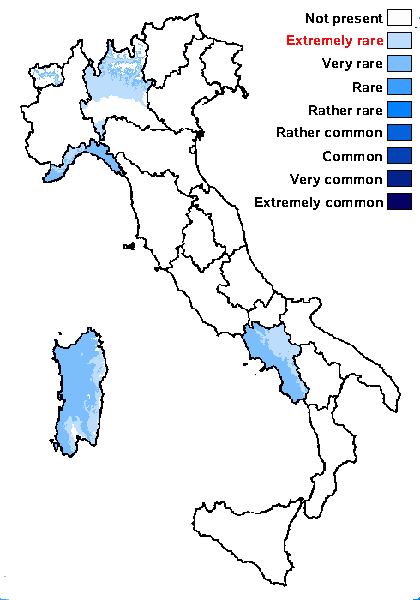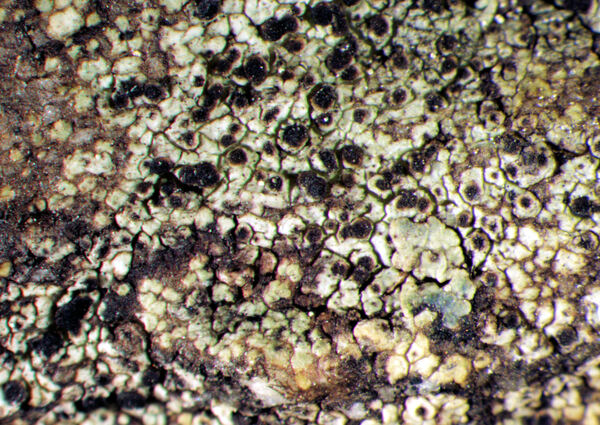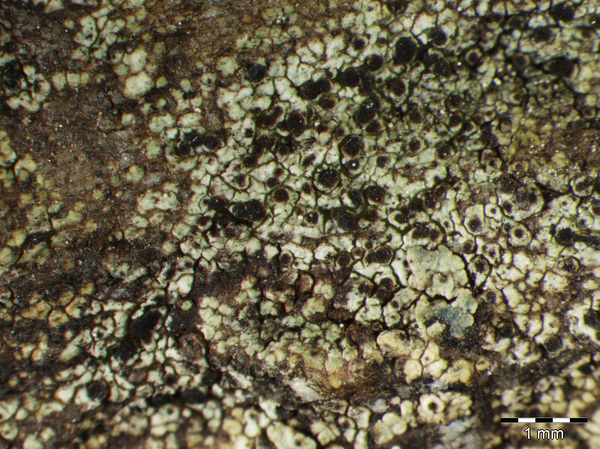Rinodina occulta (Körb.) Sheard
Lichenologist, 3: 349, 1967. Basionym: Buellia occulta Körb. - Parerga Lichenol.: 186, 1860.
Synonyms: Lecanora tegulicola Nyl.; Rinodina diplocheila Vain.; Rinodina tegulicola (Nyl.) J. Steiner; Rinodina verrucarioides H. Magn.
Distribution: N - Lomb (Favero-Longo & al. 2023), VA (Piervittori & Isocrono 1999, Matteucci & al. 2015d), Lig. C - Sar. S - Camp (Jatta 1909-1911).
Description: Thallus crustose, episubstratic, thin, areolate-verrucose, grey to ochraceous brown, often delimited by a dark prothallus. Apothecia at first lecanorine and subimmersed, then soon cryptolecanorine to lecideine and adnate, usually abundant and confluent, 0.1-0.3 mm across, with a soon convex, brown-black disc, and a thin, often soon excluded proper margin, sometimes with an ephemeral thalline margin when very young. Exciple poorly developed, sometimes containing a few algal cells at base; epithecium c. 10 µm high, red-brown to dark brown; hymenium colourless, 50-80 µm high; paraphyses 1.5-2 µm thick at mid-level, the apical cells, capitate, 3-6 µm wide, with a brown cap; hypothecium colourless, to 60 µm high. Asci 8-spored, clavate, the K/I+ blue tholus penetrated by a faintly amyloid apical cushion with parallel or diverging flanks, the wall K/I-, surrounded by a K/I+ blue outer layer, Lecanora-type. Ascospores 1-septate, brown, ellipsoid (10-)12-16(-18) x (5.5-)6-8 µm, Physcia-type, some of them tending towards the Physconia-type at maturity, the torus poorly developed, the ontogeny of type A (apical wall thickening after septum formation). Photobiont chlorococcoid. Spot tests: thallus K+ yellow (reaction often faint), C-, KC-, P- or P+ faintly yellow. Chemistry: cortex with atranorin and chloroatranorin.Note: on vertical or rain-sheltered surfaces of hard siliceous rocks; to be looked for more intensively, especially in Tyrrhenian Italy and in the dry Alpine valleys.
Growth form: Crustose
Substrata: rocks
Photobiont: green algae other than Trentepohlia
Reproductive strategy: mainly sexual
Most common in areas with a humid-warm climate (e.g. most of Tyrrenian Italy)
In underhangs rarely wetted by rain
Commonnes-rarity: (info)
Alpine belt: absent
Subalpine belt: absent
Oromediterranean belt: absent
Montane belt: very rare
Submediterranean belt: extremely rare
Padanian area: absent
Humid submediterranean belt: very rare
Humid mediterranean belt: very rare
Dry mediterranean belt: absent

Predictive model
Growth form: Crustose
Substrata: rocks
Photobiont: green algae other than Trentepohlia
Reproductive strategy: mainly sexual
Most common in areas with a humid-warm climate (e.g. most of Tyrrenian Italy)
In underhangs rarely wetted by rain
Commonnes-rarity: (info)
Alpine belt: absent
Subalpine belt: absent
Oromediterranean belt: absent
Montane belt: very rare
Submediterranean belt: extremely rare
Padanian area: absent
Humid submediterranean belt: very rare
Humid mediterranean belt: very rare
Dry mediterranean belt: absent

Predictive model
 Index Fungorum
Index Fungorum
 GBIF
GBIF



